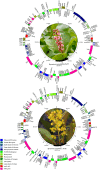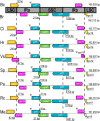Chloroplast genomes of Byrsonima species (Malpighiaceae): comparative analysis and screening of high divergence sequences
- PMID: 29396532
- PMCID: PMC5797077
- DOI: 10.1038/s41598-018-20189-4
Chloroplast genomes of Byrsonima species (Malpighiaceae): comparative analysis and screening of high divergence sequences
Abstract
Byrsonima is the third largest genus (about 200 species) in the Malpighiaceae family, and one of the most common in Brazilian savannas. However, there is no molecular phylogeny available for the genus and taxonomic uncertainties at the generic and family level still remain. Herein, we sequenced the complete chloroplast genome of B. coccolobifolia and B. crassifolia, the first ones described for Malpighiaceae, and performed comparative analyses with sequences previously published for other families in the order Malpighiales. The chloroplast genomes assembled had a similar structure, gene content and organization, even when compared with species from other families. Chloroplast genomes ranged between 160,212 bp in B. crassifolia and 160,329 bp in B. coccolobifolia, both containing 115 genes (four ribosomal RNA genes, 28 tRNA genes and 83 protein-coding genes). We also identified sequences with high divergence that might be informative for phylogenetic inferences in the Malpighiales order, Malpighiaceae family and within the genus Byrsonima. The phylogenetic reconstruction of Malpighiales with these regions highlighted their utility for phylogenetic studies. The comparative analyses among species in Malpighiales provided insights into the chloroplast genome evolution in this order, including the presence/absence of three genes (infA, rpl32 and rps16) and two pseudogenes (ycf1 and rps19).
Conflict of interest statement
The authors declare that they have no competing interests.
Figures




References
-
- Cooper, G. M. Chloroplasts and other plastids in The Cell: A Molecular Approach. 2nd edition. Sunderland (MA): Sinauer Associates. Available from: https://www.ncbi.nlm.nih.gov/books/NBK9905/ (2000).
-
- Palmer, J. D. Plastid chromosomes: structure and evolution in cell culture and somatic cell genetics of plants (ed. Bogorad L. K., Vasil, I.). San Diego (CA): Elsevier (1991).
Publication types
MeSH terms
LinkOut - more resources
Full Text Sources
Other Literature Sources
Molecular Biology Databases
Miscellaneous

